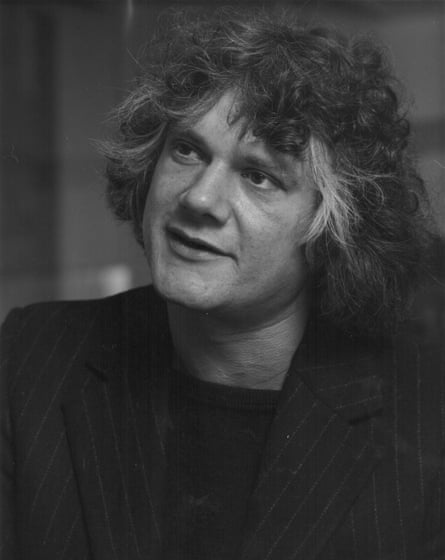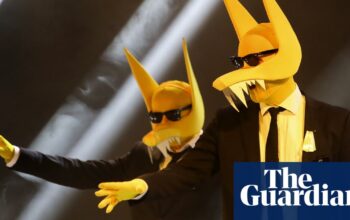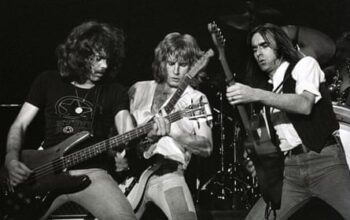One of the most significant moments in the professional life of Tony Oxley, a British drummer and percussionist, occurred when he joined a trio led by renowned American jazz pianist Bill Evans for a successful European tour. He was then invited to continue as a permanent member when the group returned to the US in 1972. While this would have elevated his status in the jazz community, Oxley chose to decline the offer in order to focus on his goal of expanding his musical abilities as both a performer and composer.
In the cover image of Oxley’s album, Ichnos, from the same year, his determination was evident. The drum set featured in the photo appeared to be made from various scrap materials, including regular drums and cymbals adorned with an upturned cooking pot, washboard, film reel, and other steel and aluminum objects. Later on, a pair of bongos would replace the snare drum, and a large, specially-made cowbell was also incorporated.
Oxley, who passed away at the age of 85, was highly skilled in traditional drumming techniques and had a deep understanding of the complex structures and patterns of modern jazz. He developed his talents during his time as the resident drummer at Ronnie Scott’s Club in London during the late 1960s, playing alongside renowned American artists like Sonny Rollins and Blossom Dearie. However, his creative approach can be summarized by his thoughts on jazz musicians who simply imitate their American idols, such as Art Blakey: “It becomes evident quickly that there is only one Art Blakey. If you cannot find your own unique voice, then life as a musician will be challenging.”
Oxley’s determined and direct approach to criticism reflected his upbringing in South Yorkshire. He forged his own unique musical path, straying from conventional genres and opting for improvised music. In live performances, he would use a variety of sound sources, such as electronics, to create a dynamic and ever-expanding sound. With a calm and precise technique, he expertly utilized the response and resonance of each surface he struck, producing a captivating tapestry of effects. Whether performing solo or collaborating with like-minded musicians, such as pioneering jazz avant-garde pianist Cecil Taylor and innovative saxophonist Anthony Braxton, Oxley’s drumming always left a lasting impression.
Born into a working-class Sheffield family, Oxley played the piano for a while during childhood but took up the drums as a teenager. While playing in dance bands at night, he was sacked from his regular work in a cutlery-making firm for sleeping on the job.
He served in the Black Watch, the 3rd battalion of the Scottish Regiment, as part of his national service. During this time, his musical skills such as instrumental technique, sight-reading ability, and overall musicianship were improved while playing in both military bands and the regimental orchestra. He had the opportunity to utilize a variety of percussion instruments, including tympani, glockenspiel, and triangle, in performances of classical repertoire. While many viewed national service as a burden, Oxley saw it as a valuable opportunity to devote three years to studying music without the pressure of having to make a living from it.
Following his departure from the military, he embarked on multiple journeys to New York with a dance band, entertaining passengers aboard the Queen Mary. During his shore leave, he took the opportunity to explore the city’s vibrant jazz scene and witness performances by influential artists. In between these trips, he played in a cabaret band in Chesterfield, but by 1963, he also had Saturday afternoon gigs at a pub in Sheffield called the Grapes, alongside other up-and-coming jazz musicians.
A new trio was formed, humorously named after a little-known English composer. The members were Oxley, Derek Bailey, a guitarist from Sheffield, and Gavin Bryars, a philosophy student at Sheffield University, on bass. According to Bailey’s biographer, Ben Watson, they shared a dislike for things that were overly predictable.
In their early years, they sought influence from sources outside of jazz such as the compositions of Webern, Stockhausen, Morton Feldman, and John Cage. Oxley experimented with a unique system of dividing the traditional 4/4 beat by layering eighth note triplets over quarter note triplets, resulting in a 18-beat measure. He shared his concept in Crescendo, a magazine for dance bands, but it was met with confusion by many.
After the group disbanded in 1966, following a brief tour with American saxophonist Lee Konitz, Bailey and Oxley went their separate ways to London. Oxley joined pianist Gordon Beck’s trio, while Ronnie Scott invited him to become the resident drummer at his club. Scott also offered Oxley a spot in his own bands, including an innovative octet with up-and-coming musicians.
In 1969, John McLaughlin, a young guitarist, gained widespread acclaim for his album “Extrapolation,” which featured a quartet consisting of Oxley, John Surman on saxophone, and Brian Odgers on bass. While also playing in a group that incorporated rock influences, the drummer spent time at the Little Theatre Club in Covent Garden, where smaller but devoted audiences witnessed more intense musical experimentation.

In 1970 and 1971, Oxley released two albums under the CBS label. The first one, titled “The Baptised Traveller,” featured regulars from the Little Theatre Club such as trumpeter Kenny Wheeler, saxophonist Evan Parker, bassist Jeff Clyne, and Bailey. It was a four-part suite with three compositions by Oxley and a piece called “Stone Garden” by saxophonist Charlie Mariano, who Oxley had previously played with at Scott’s. The album is considered a classic of British jazz from that time period, showcasing a unique blend of unconventional instrumental techniques and moments of graceful contemplation.
Oxley was a part of Alan Skidmore’s exceptional quintet, where he played the saxophone. The group received multiple accolades at the Montreux jazz festival in 1969, including best group, best soloist, and best drummer. Oxley was also recognized as the top British jazz drummer by readers of the Melody Maker, winning the award every year from 1969 to 1972. He started incorporating amplification into his drum kit while playing with pianist Howard Riley’s trio.
In 1970, Oxley, Bailey, and Parker started their own independent record label, Incus, when it became clear that major record companies were no longer interested in recording their music. Despite clashes leading to Oxley and Parker leaving, Incus continued to release over 50 albums.
During the 1970s, Oxley frequently served as a tutor for the well-attended jazz course at the Barry summer school in south Wales. In 1976, he also held a position as an artist in residence at the Sydney Conservatorium of Music in Australia, where he taught improvisation. However, his focus was gradually shifting to continental Europe, specifically Germany, where he had established his residence. In 1988, Oxley participated in a series of recording sessions in Berlin, organized by producer Jost Gebers, that showcased collaborations between Taylor and various European musicians.
His successful duo session with Taylor began a musical relationship that lasted 20 years and included tours of the US and Europe, sometimes with the bassist William Parker in a group that became known as the Feel Trio. Among the duo’s albums was a set recorded at the Village Vanguard in New York in 2008.
Oxley continued to play and make music in different settings, such as the London Jazz Composers Orchestra, his own multinational Celebration Orchestra, a group of three called SOH with Skidmore and the German bassist Ali Haurand, various ensembles with pianists Paul Bley, Alexander von Schlippenbach, and Stefano Battaglia, and trumpeters Bill Dixon, Enrico Rava, and Tomasz Stanko. He also formed a duo with Scottish painter and musician Alan Davie, who gave him a violin to add to his collection of percussion instruments. In 1998, the Joseph Holbrooke Trio came together again for a radio broadcast in Cologne, which was later released by Incus, and a subsequent studio recording in London.
In 2023, the Discus label released The New World, an album of electronic and acoustic percussion music, which showcased abstract paintings by the artist.
He is survived by his spouse, Tutta (formerly known as Rütten), whom he wed in 2000.
Source: theguardian.com


